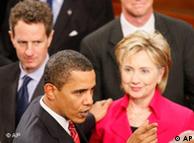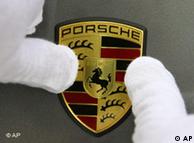历史的教训:1929纽约金融风暴80周年
——纽约曼哈顿的市中心阴雨绵绵:在金融区的建筑中,游客们手中的雨伞给灰色的背景上增添了一抹五彩的基调。2009年10月--为纪念1929年 华尔街金融危机爆发80周年,纽约的"金融博物馆"组织了一次环城游活动。这位年轻女教师对此感到十分兴奋:“我非常期待。我在之前已经对此作了一些相关 的了解。我们是跟着新罕布什尔州大学的一个投资管理学研修班来到这儿的,为的就是参观纽约的股票交易所和一些其他景点。当我们得知有这么一个环城游的活动 之后,就提前几天过来了。”
李察德·沃斯豪威尔和詹姆斯·卡普兰担任这种活动的向导已经有20多年了,李察德说,他们总是装备着扩音喇叭,并且风雨无阻:"组织这次活动的目的 就是让人们通过华尔街这个缩影,了解纽约金融、房地产、建筑和政治等方面的历史。今年是华尔街金融危机爆发80周年,这也是股票历史上的一个重大事件。"
游客们直接在见证历史的地点--闻名全世界的华尔街股票交易所门前集合。
在纽约证券交易所对面,联邦大厦门前的台阶上,游客们撑着伞,聚精会神地倾听讲解员詹姆斯再现当年的历史。他谈起了黄金般的20年代--当时由于整 个欧洲都由于战争的毁灭而一蹶不振,美国则一跃为世界上最重要的供货商。美国的生产和技术革新出现欣欣向荣的景象--纽约大学经济史学教授李察德·希拉这 样回忆道:"飞机、无线电广播、电影和电子科技--20年代是一个令人乐观向上的时代。但似乎当形势发展得过于令人乐观的时候,就会出现失控的情况:人们 开始不惜冒巨大的风险,利用金钱进行投机倒把,把股票价格推到了令人眩晕的高度。"
而每个人都是造成危机原因的一分子:只要钱不够花了,就去借--那个年代,贷款炒股是轻而易举的事情。
1929年9月初,道琼斯股指攀上了381点的高峰,之后由于美联储提高利率,股票一度轻微下跌。直到10月24日--那个黑色的星期四,股市刚一开盘就暴跌了两成。富有的投资商和银行家以闪电式的收购股票作为回应,希望能支撑住狂跌的股价。李察德·希拉接着回忆道:"
"在之后的星期五和星期六,股市的情况还算差强人意,但是到了星期一,也就是10月28日,股票再次暴跌了10%到11%。到星期二,10月29 日,股市再次下滑10%。也就是说,在两天之内,股票价格整整跌了21%到22%。所以人们常把这两天称作黑色星期一和黑色星期二,而它们也就成为了那场 金融风暴的代名词。"
 Bildunterschrift: Großansicht des Bildes mit der Bildunterschrift: 到30年代初,危机席卷全世界,德国当然也被波及
Bildunterschrift: Großansicht des Bildes mit der Bildunterschrift: 到30年代初,危机席卷全世界,德国当然也被波及在那次崩盘之后,股市仍然显现出了一段时间的回升,并一直持续到1930年的4月。尽管很多银行家在经历了那场劫难之后就倾家荡产,一夜之间变得身 无分文,但是大多数民众直到若干年之后才真正感受到危机的到来:1932年,每四个美国人当中就有一个失业,物价暴跌,经济生产总量缩水三分之一。数千家 银行倒闭--政府认为这是它们自作自受。
经济史学家李察德·希拉表示:""当经济大萧条刚来临的时候,政府基本上是袖手旁观,结果导致形势每况愈下,直到1932年,胡佛总统才采取了一些 类似干预的手段,因为那时候情况实在是太糟了。1933年3月,罗斯福总统上台,政府才真正开始行动,而这些措施其实早在两三年前就应该实施了。"
在这一点上,2009年出现经济危机时,全球各国政府的表现就截然不同了:它们都迅速采取了果断的措施来应对危机。
以金融危机为主题的环城游结束了,讲解员李察德认为,1929年的金融风暴和我们今天面临的危机也有相似之处。"每当股市暴涨的时候,我们总是一味 地相信这种形势会永远持续下去。但是历史告诉我们,在股票上涨之后,它总是会下跌的。这是一个循环,是我们无法改变的规律。我们给不同时期的经济危机赋予 不同的名称,总结出不同的特点,但它们本质上都是一样的,我们都逃脱不了这个循环。"
那么对于这个问题,学术界是怎么看的呢?金融市场专家曼弗雷德·叶戈尔来自位于科隆的德国经济研究所,他认为1929年金融危机和今天的全球经济危 机第一个相似点就是,它们都具有全球性,而不是局限在某一个地域范围内或某一个领域的局部性危机。"这两次经济危机的相似之处在于负债率过高。也就是说, 过多的人用借来的钱进行投资,因此投资一旦不成功,就会遇到资金瓶颈。由于人们没有资本偿还这些损失,就导致出现资金缺口,随后整个市场就开始螺旋下 滑。"
根据曼弗雷德·叶戈尔的观点,政府为了应对今年的金融危机所采取的措施是有效的--显然政界也从历史中吸取了教训。"上世纪30年代出现大萧条后, 各国采取了带有浓重保护主义色彩的措施,导致国际贸易滑坡,又更加剧了经济萧条。谢天谢地,我们目前还没有出现这种情况,但愿这种现状能维持下去。"
 Bildunterschrift: Großansicht des Bildes mit der Bildunterschrift: 2009年经济危机到来之后,美国等世界各国均采取了果断的应对措施
Bildunterschrift: Großansicht des Bildes mit der Bildunterschrift: 2009年经济危机到来之后,美国等世界各国均采取了果断的应对措施从目前的形势看,受挫的国际贸易也许可以较为轻松地走出低谷,这在金融专家叶戈尔看来是一个重要的优势。两次金融危机的另外一个明显区别就是,政府 在货币政策上的反映不同。80年前,美国政府采取了提高利率的方法,这就相当于"抽走了资金流通的血液",叶戈尔说:"在这次的金融危机中,政府采取了截 然相反的做法,它们向资金流通中注入了大量的额外血液,这就有效促进了金融市场的稳定。"
金融专家叶戈尔认为,目前的国际金融市场上还不存在真正的信贷紧缩困境。企业还是能得到所需的贷款。但是,假如未来一段时间资本的流动出现停滞,并 影响到经济增长,那么目前的这场金融危机就很有可能演变为一场大萧条。叶戈尔说:"假如再度出现经济负增长,就可以将其称为经济萧条了。然而,我们认为这 种情况出现的可能性不是很大。假如我们将之与日本此前经历的十年经济萧条相比较就会发现,我们所真正面临的威胁是什么。因为日本正是在金融市场出现危机之 后没能选取正确的经济政策,才导致它的经济发展被耽误了整整十年。"
现在,各国政府手中应对危机的唯一"良方"就是:通过谨慎温和的减税措施来减轻企业负担,同时又不能使国家财政背上过重的包袱。这也许能使就业市场的严峻形势得到一定缓解。
1929年的那个"黑色星期一"已经过去整整80年了,在这80年中,世界经济和人类生活都发生了翻天覆地的变化,但为什么相似的金融风暴能够在21世纪再度席卷华尔街并波及全世界,恐怕是人们除了应对眼前的危机之外,最应该深思和反省的问题。
作者:Miriam Braun/Klaus Ulrich/雨涵
责编:石涛
*****
高伯瑞(John K. Galbraith, 1908-2006)這本1954年出版,後來不斷重印,
本書有著下述意義:
(一)它是截至當時,
(二)人們現在已知道,高伯瑞寫作,一般都至少要五易其稿、
(三)對高伯瑞的著作與思想有理解的人都知道,
貪婪總是會付出代價的。1920年代是美國樂觀輕快、
而人類所犯的錯雖然不可能如原樣般重現,
|
| 今昔對比/詹姆士.高伯瑞 |
1929年的大崩盤和2008年的金融海嘯相似之處就在此。
|
|
為什麼全世界都在讀這本書?!
人類的愚昧會不斷重演,因此每個人都該了解這段歷史!
|
1929年大崩盤
作者:約翰‧高伯瑞(John Kenneth Galbraith)
定價350元 規格:硬殼精裝
目錄
序言 九0年代的觀點
第一章 「夢幻、無窮的希望與樂觀主義」
第二章 應該有所作為?
第三章 我們信賴的高盛
第四章 幻想的暮光
第五章 大崩盤
第六章 越來越嚴峻的情勢
第七章 後果
第八章 後果(二)
因與果
|
歷史上永恆的投資/經濟經典
★美國《財富》雜誌、《紐約時報》、《聖路易郵報》、《
★作者高伯瑞之子,著名的經濟學家詹姆士‧高伯瑞專文推薦!
★國內專家學者沈雲驄、南方朔、劉憶如專業推薦!
【內容簡介】
《1929年大崩盤》這本書最早於1954年出版,此後在195
猖獗的投機。創紀錄的交易量。人們大肆購買資產,
1929年的大崩盤和2008年的金融海嘯相似之處在於,
而不願再被歷史的愚昧所左右的你我,該是時候停止猜測,
開卷嚴選:1929年大崩盤
http://blog.chinatimes.com/ 1929年大崩盤精彩PPT檔 http://addons.books.com.tw/G/
【各界讚譽】
‧ 美國《財富》雜誌將《1929年大崩盤》列為其推薦的75本必讀
‧ 《聖路易郵報》認為《1929年大崩盤》是經濟學大師「
‧ 《大西洋月刊評論》則評論說:「
‧ 《紐約時報》盛讚:「作者以其精湛、引人入勝的筆觸,
|
約翰‧高伯瑞(John Kenneth Galbraith, 1908-2006)
美國二十世紀經濟學界的代表人物,曾任哈佛大學華伯格(Paul M. Warburg)經濟學講座名譽教授,擔任美國藝文學會(Ame
1941~1943年:擔任美國物價管理局副局長。
1946年:杜魯門總統頒發自由勳章(Medal of Freedom)
1961~1963年:任美國駐印度大使。
1972年被選為美國經濟協會主席。
1997年獲得加拿大的羅伯特肯尼迪圖書獎的終身成就。
2000年8月:柯林頓總統頒發自由勳章。
2001年:獲頒Padma Vibhushan獎(印度第二高榮譽的公民獎),
高伯瑞生前共有31本著作,包括《不確定的年代》、《
|
在股市大崩盤之後,緊接而來的經濟大蕭條持續了10年之久,
在這個讓人沮喪的時代,1929年就像神話般的美好。
整體來說,股市大崩盤比隨後發生的經濟蕭條更容易解釋。
1. 所得分配不均。
在1929年,富人確實是有錢人。
這種極不平等的所得分配,
在1929年11月,股市大崩盤之後數個星期,
企業最嚴重的弱點源自於控股公司和投資信託公司的龐大架構。
3. 不良的銀行體系。
從三○年代早期以來,這個新世代的美國人在聽到有關二○
然而,雖然1929年的銀行業者並不是特別的愚蠢,







